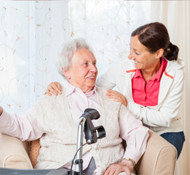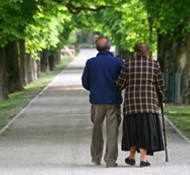Independent Living with Support Services
Independent Living is ideal for seniors who are looking for companionship and freedom from issues involving housekeeping, laundry, transportation, and preparing meals. The larger apartment-style communities have a hotel feel.
Residents customarily have a community dining room with a wait staff. They often have a beauty salon, vans or buses for transportation, and community areas such as a library, TV room, gym, etc. Apartments vary in size from studio to two-bedroom.
Independent Living is great for seniors who are on the go and who are able to live on their own but who also enjoy the shared dining experience and relief from the upkeep of a home or apartment.
Keep in mind, there is no administration of medications or medical care in Independent Living-that is the responsibility of the resident or family.
Payment option is private pay.
Assisted Living/Personal Care Home
Many Assisted Living/Personal Care Homes are styled to resemble apartments ranging from 20-200 residents with 24-hour, on-site security, or can be a smaller, home-like setting. They provide assistance with activities common to daily living, such as: supervising and administering medications, bathing, dressing, ambulating, and transferring and assisting with personal hygiene, including incontinence management. Many of these communities also have restaurant-style dining, laundry and housekeeping services, activities, community events, and transportation services. Some communities can accommodate residents with mild Alzheimers or Dementia.
Payment options for Assisted Living or Personal Care can be private pay, long-term insurance (depending on individual policy), VA Aide and Attendance (if eligible), or Social Security/SSI benefits. Monthly charges vary, depending on the facility.
Alzheimers/Dementia Care
These Assisted Living or Personal Care Homes are specifically designed, maintained, and staffed for people who have Alzheimers or other forms of Dementia. These facilities have a unique design, including alarms on all doors to prevent wandering. Staff typically have taken special courses and/or seminars to increase their knowledge of caring for seniors with behaviors such as aggression, depression, and confusion.
Floor plans are usually one level to allow ease of ambulation. Most homes have novelties such as textured pictures on the walls for sight and touch, as well as enclosed courtyards for freedom of movement while maintaining security.
Payment options are private pay, long-term insurance (depending on individual policy), VA Aide and Attendance (if eligible), or Social Security/SSI benefits.
Monthly charges vary, depending on facility.
Respite Care/Short-Term Care
Family caregivers face many challenges. Caregiving is a demanding task, and it is easy to neglect one’s own health and well-being when involved with a loved one’s needs. Caregivers need time off from their responsibilities to relieve stress and to prevent burnout.
Respite Care provides time off for family members who care for someone who is ill, injured, or frail. It can take place in an adult day center or in a residential setting, such as an Assisted Living/Personal Care Home or Nursing Home. Although there are different approaches to respite care, all have the same objective: to supply caregivers with planned, temporary, intermittent, substitute care while allowing for relief from the daily responsibilities required of a loved one. Respite Care is essential for all family caregivers.
Payment option is private pay.
Nursing Homes or Skilled Nursing Facilities
A Skilled Nursing facility has registered nurses who provide 24-hour care to people who can no longer care for themselves due to physical, emotional, or mental conditions. A licensed physician supervises each patient’s care, and a nurse or other medical professional is always on the premises. Skilled Nursing facilities provide medical care such as wound care, IV medication administration and management, injections, IV hydration, tube feedings, rehab following an accident or surgery, etc. Skilled Nursing facilities also care for patients who are bed bound.
Most medical insurance coverage follows Medicare guidelines. Private insurance and Medicare pay for Skilled Nursing for a limited time period following hospitalization. The Medicare guidelines for a Skilled Nursing facility are as follows:
- The patient must have been hospitalized for at least three days
- The patient must enter the nursing home within 30 days of discharge from the hospital
- Only the first 20 days are 100% covered. Day 21 up to day 100 result in a daily deductible. Medical coverage may cover the deductibles and some other charges
- There is a 100-day maximum related to one hospitalization or diagnosis
- The patient must be making regular progress as documented by medical professionals. If progress towards independence “plateaus,” insurance coverage ends
Long-Term Care
Long-Term Care provides care for those who may have completed their rehab program, but who still need more than a family can provide. An Assisted Living/Personal Care Home can also provide Long-Term Care for seniors requiring constant assistance with activities of daily living and medical care under 24-hour supervision. Residents in nursing care will have their daily medical, physical, social, and psychological needs met with help of nursing staff under the direction of physicians and nurses.
Hospice
Hospice represents a compassionate approach to end-of-life care. Hospice is more a concept of care then a specific place. It is an option for people whose life expectancy is limited, and involves palliative (pain and symptom relief) rather than on-going, curative measures. Hospice enables patients to live end-days to the fullest with purpose, dignity, and grace.
Hospice care can be provided in a Nursing Home or Assisted Living/Personal Care Facility.
Hospice pays for all medications and equipment pertaining to admitting diagnosis.


